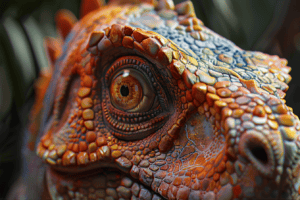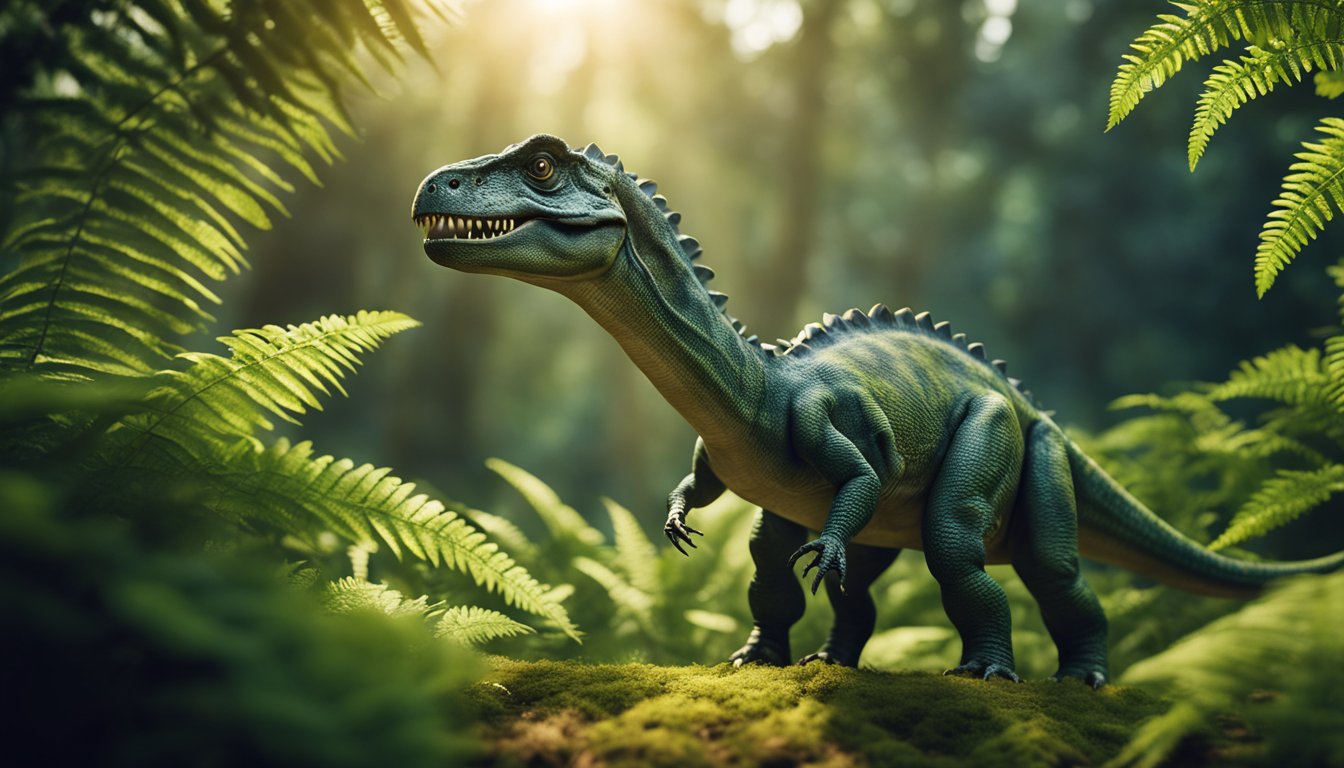Fabrosaurus, the little dinosaur with big implications, is a fascinating creature that roamed the earth during the Early Jurassic period.
This herbivorous dinosaur was discovered in southern Africa, specifically in Lesotho, and has been the subject of much scientific study since its discovery.
Despite being a relatively small dinosaur, Fabrosaurus has played a significant role in our understanding of prehistoric life.

Fabrosaurus is a genus of dinosaur that is believed to have lived around 189-199 million years ago.
It was first discovered by scientists Leonard Ginsburg and Jean Fabre in Basutoland, which is now known as Lesotho.
The fossils of Fabrosaurus were excavated in the Upper Elliot Formation of southern Africa, and they comprised only parts of the skull.
Despite the limited fossil evidence available, scientists have been able to learn a great deal about this dinosaur and its place in the prehistoric world.
Unearthing the Past

Fabrosaurus, a small herbivorous dinosaur, may be little in size, but its discovery has big implications for the field of paleontology.
In this section, we’ll take a closer look at the fossils and discoveries that led to the identification of this fascinating dinosaur, as well as its place in the early Jurassic landscape.
Fossils and Discoveries
Fabrosaurus was first discovered in the early 1960s in Southern Africa by paleontologists Leonard Ginsburg and Jean Fabre.
The fossils they found were fragmentary, consisting of only a portion of a jaw, but they were enough to identify a new genus of dinosaur.
The name Fabrosaurus comes from a combination of Fabre’s name and the Greek word for “lizard.”
The fossils of Fabrosaurus are important because they represent one of the earliest known ornithischian dinosaurs, a group that includes some of the most famous dinosaurs like Triceratops and Stegosaurus.
Ornithischians are characterized by their bird-like hips, which set them apart from other dinosaurs like theropods and sauropods.
Fabrosaurus in the Early Jurassic Landscape
Fabrosaurus lived during the Early Jurassic Period, around 199 to 189 million years ago.
During this time, Southern Africa was a very different place than it is today.
It was a lush, tropical environment with dense forests and swamps, home to a diverse range of animals including other early dinosaurs like Massospondylus and Lesothosaurus.
Fabrosaurus was a small dinosaur, only about the size of a turkey, and it likely spent most of its time foraging for ferns and other vegetation.
Its small size may have been an adaptation to the dense vegetation of the Jurassic landscape, allowing it to navigate through the underbrush more easily than larger dinosaurs.
The Mystery of Lesothosaurus
One of the interesting things about Fabrosaurus is that it may actually be the same dinosaur as another early ornithischian called Lesothosaurus.
The fossils of Lesothosaurus were discovered in the same area of Southern Africa as Fabrosaurus, and they share many similarities in their anatomy.
However, some paleontologists believe that there are enough differences between the two dinosaurs to warrant keeping them separate.
For example, Fabrosaurus had a more robust jaw than Lesothosaurus, which may have allowed it to eat tougher plants.
Despite this ongoing debate, both Fabrosaurus and Lesothosaurus represent important discoveries in the field of paleontology.
They provide valuable insights into the early evolution of ornithischian dinosaurs and the ecosystems they inhabited during the Jurassic Period.
A Glimpse into Fabrosaurus Biology
Anatomy of a Small Herbivore
Fabrosaurus was a small, bipedal, herbivorous dinosaur that lived during the Early Jurassic period, around 199 to 189 million years ago.
As an ornithischian dinosaur, it had a bird-like hip structure, with its pubis bone pointing backward.
Fabrosaurus had a small, slender body, measuring only about 1 meter in length and weighing around 10 kilograms.
It had long, slender legs that were adapted for running and a long tail that helped it maintain balance.
Fabrosaurus had a small, narrow skull with a pointed snout and large eye sockets.
It had a relatively large brain for its size, which suggests that it had good vision and cognitive abilities.
Fabrosaurus had a unique dentition that consisted of small, leaf-shaped teeth that were adapted for cutting and grinding plant material.
Diet and Survival
As a herbivorous dinosaur, Fabrosaurus primarily fed on low-lying vegetation such as ferns, horsetails, and cycads.
Its small size and agile body allowed it to navigate through dense vegetation to find food.
Fabrosaurus had a unique jaw structure that allowed it to chew its food efficiently.
Its lower jaw had a hinge-like joint that allowed it to move forward and backward, which helped it grind plant material more effectively.
Fabrosaurus lived in a terrestrial habitat, likely in open forests or grasslands.
Its small size and herbivorous diet made it vulnerable to predation by larger carnivorous dinosaurs, such as Dilophosaurus and Coelophysis.
Fabrosaurus likely used its speed and agility to avoid predators and may have lived in herds for protection.
Fun Fact: Fabrosaurus was named after Jean Fabre, a French geologist who discovered the first fossils of the dinosaur in Basutoland, Southern Africa.
Fabrosaurus and the Great Dinosaur Family

Relatives and Evolution
Fabrosaurus was a small ornithischian dinosaur that lived during the early Jurassic period, around 200 to 189 million years ago.
It was a herbivore, meaning it only ate plants. Despite its small size, Fabrosaurus has big implications for our understanding of dinosaur evolution.
Scientists believe that Fabrosaurus is closely related to other early ornithischian dinosaurs, such as Heterodontosaurus, Hypsilophodon, and Iguanodon.
These dinosaurs were some of the first to evolve specialized teeth for grinding plant material, which allowed them to exploit new food sources and thrive in a rapidly changing environment.
Fabrosaurus is also important because it belongs to a larger group of dinosaurs called the ornithopods, which includes the famous hadrosaurs, or “duck-billed” dinosaurs.
Ornithopods were among the most successful and diverse groups of dinosaurs, evolving a wide range of adaptations for feeding, locomotion, and social behavior.
Comparisons with Other Dinosaurs
Compared to other dinosaurs, Fabrosaurus was relatively small, measuring only about 1 meter long and 0.3 meters high.
It had a slender build, with long legs and a short tail. Its teeth were small and pointed, adapted for slicing through tough plant material.
Despite its small size, Fabrosaurus was a fast and agile runner, able to evade predators such as early theropod dinosaurs.
It also had a keen sense of smell, which helped it locate food and avoid danger.
In many ways, Fabrosaurus was a typical early ornithischian dinosaur, with features that would become more specialized and diverse in later dinosaurs.
By studying the fossils of Fabrosaurus and its relatives, scientists can piece together the story of how dinosaurs evolved and adapted over millions of years.
Frequently Asked Questions

How big were the smallest dinosaurs that roamed the Earth?
Dinosaurs came in all shapes and sizes, from towering giants to tiny creatures no bigger than a chicken.
The smallest known dinosaur is the bee hummingbird-sized Microraptor which measured only about 16 inches long.
However, Fabrosaurus was a bit larger, measuring up to 3 feet long.
Despite their small size, these little dinosaurs played an important role in the ecosystem of the time.
Can you tell me what dinosaurs were the size of a house cat?
Sure! There were several dinosaurs that were about the same size as a house cat.
One of the most famous is the Compsognathus, which was a small carnivorous dinosaur that lived during the Late Jurassic period.
Other small dinosaurs include the Oviraptor and the Troodon, both of which were about the same size as a large dog.
What fascinating insights have we learned from studying Fabrosaurus fossils?
Although Fabrosaurus was small, it has given us a lot of information about the early Jurassic period.
Scientists have studied the bones of Fabrosaurus to learn about its diet, behavior, and habitat.
For example, they have found evidence that Fabrosaurus was a herbivore that ate ferns and other vegetation.
They have also discovered that it lived in Africa during the Lower Jurassic period, around 199 to 189 million years ago.
In what ways did tiny dinosaurs like Fabrosaurus contribute to our understanding of prehistoric life?
Tiny dinosaurs like Fabrosaurus have given us a unique window into the past.
By studying their fossils, we can learn about the ecosystems and environments of the time.
We can also learn about the evolution of dinosaurs and how they adapted to changing conditions over time.
Additionally, studying tiny dinosaurs can help us understand the broader patterns of life on Earth and how different species interacted with each other.
How did Fabrosaurus compare in size to the dinosaurs featured in popular movies?
Fabrosaurus was much smaller than the dinosaurs you might see in movies like Jurassic Park.
While those dinosaurs were often as large as buildings, Fabrosaurus was only about 3 feet long.
However, despite its small size, Fabrosaurus was a fascinating and important dinosaur that has taught us a lot about prehistoric life.
What was the environment like for small dinosaurs during the time of Fabrosaurus?
During the early Jurassic period, the environment was very different from what we see today.
The climate was warm and humid, and there were dense forests and swamps.
Small dinosaurs like Fabrosaurus would have lived in this environment, feeding on plants and avoiding predators.
They would have shared their habitat with other dinosaurs, as well as with early mammals and reptiles.
By studying the fossils of these creatures, scientists can learn about the complex web of life that existed during this time period.







